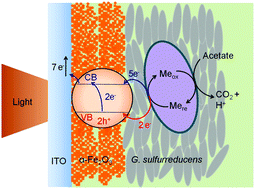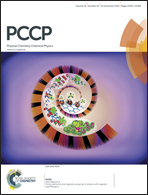Light-driven microbial dissimilatory electron transfer to hematite†
Abstract
The ability of dissimilatory metal-reducing microorganisms (DMRM) to conduct extracellular electron transfer with conductive cellular components grants them great potential for bioenergy and environmental applications. Crystalline Fe(III) oxide, a type of widespread electron acceptor for DMRM in nature, can be excited by light for photocatalysis and microbial culture-mediated photocurrent production. However, the feasibility of direct electron transfer from living cells to light-excited Fe(III) oxides has not been well documented and the cellular physiology in this process has not been clarified. To resolve these problems, an electrochemical system composed of Geobacter sulfurreducens and hematite (α-Fe2O3) was constructed, and direct electron transfer from G. sulfurreducens cells to the light-excited α-Fe2O3 in the absence of soluble electron shuttles was observed. Further studies evidenced the efficient excitation of α-Fe2O3 and the dependence of photocurrent production on the biocatalytic activity. Light-induced electron transfer on the cell–α-Fe2O3 interface correlated linearly with the rates of microbial respiration and substrate consumption. In addition, the G. sulfurreducens cells were found to survive on light-excited α-Fe2O3. These results prove a direct mechanism behind the DMRM respiration driven by photo-induced charge separation in semiconductive acceptors and also imply new opportunities to design photo-bioelectronic devices with living cells as a catalyst.


 Please wait while we load your content...
Please wait while we load your content...